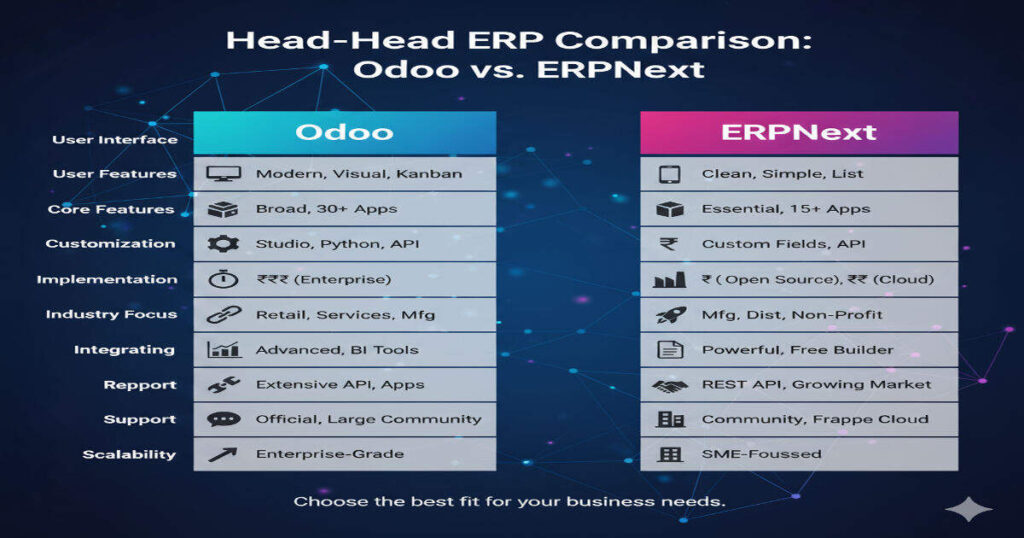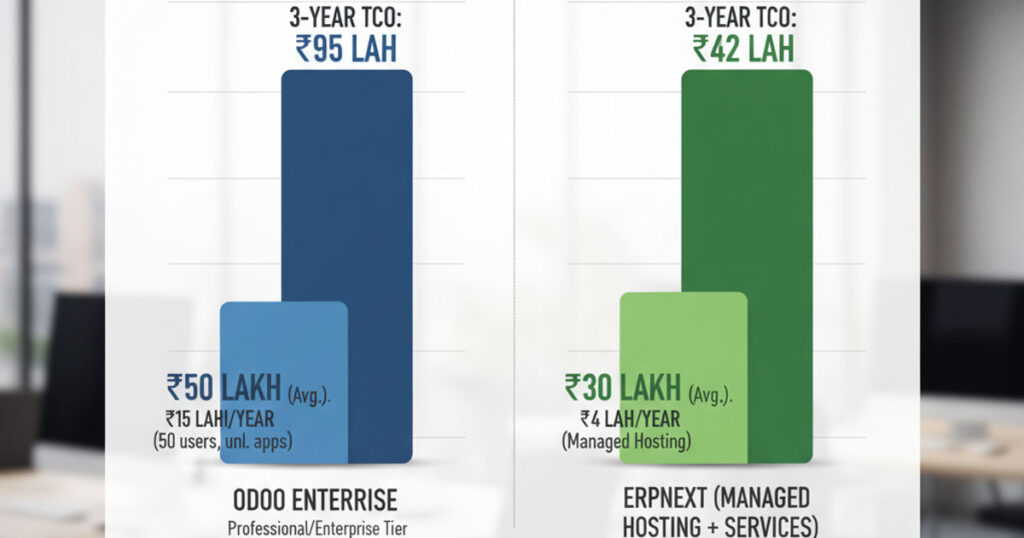Odoo vs ERPNext is one of the most crucial comparisons businesses make when choosing the right ERP system. Understanding how these two open-source platforms differ can save your company time, cost, and long-term operational challenges.
At TCB Infotech, we’ve implemented both Odoo and ERPNext across 50+ projects in 40+ industries since 2021. We’re not biased toward either platform—we recommend what’s genuinely best for each client’s specific needs. As part of our specialized Odoo implementation services, we help businesses understand exactly which ERP aligns with their operational goals. This guide shares our real-world experience to help you make an informed decision.
Understanding Odoo and ERPNext
What is Odoo?
Odoo is a comprehensive open-source ERP platform originally developed in Belgium. It offers 30+ integrated modules covering everything from accounting and inventory to CRM, e-commerce, and manufacturing. Odoo has both a free Community Edition and a paid Enterprise Edition with additional features and official support.
Key Characteristics: – Modern, intuitive interface – Extensive app ecosystem (30,000+ third-party apps) – Strong e-commerce and website builder capabilities – Active global community – Available in 80+ languages
What is ERPNext?
ERPNext is an open-source ERP system developed by Frappe Technologies in India. It’s designed specifically for small and medium businesses, with a focus on simplicity and ease of use. ERPNext is completely free and open source, with no paid enterprise version.
Key Characteristics: – Clean, straightforward interface – Built-in modules for core business functions – Strong manufacturing and distribution features – Growing community, especially in India – Completely free with no licensing costs
Head-to-Head Comparison

1. User Interface and Experience
Odoo: – Modern, visually appealing interface – Kanban views, drag-and-drop functionality – Highly customizable dashboards – Mobile-responsive design – Steeper learning curve for complex features
ERPNext: – Clean, minimalist interface – Straightforward navigation – Standard list and form views – Mobile-responsive design – Easier for non-technical users to learn
Winner: Tie—depends on preference. Odoo is more visually polished; ERPNext is more straightforward.
2. Core Functionality
Odoo Modules: – Accounting and Finance – Sales and CRM – Inventory and Warehouse Management – Manufacturing (MRP) – Purchase Management – Human Resources – Project Management – E-commerce – Website Builder – Marketing Automation – Point of Sale (POS) – Helpdesk – 20+ additional modules
ERPNext Modules: – Accounting – Sales and CRM – Stock Management – Manufacturing – Buying – Human Resources – Project Management – Asset Management – Quality Management – Agriculture – Healthcare – Education – Non-Profit
Winner: Odoo—broader range of modules and deeper features in areas like e-commerce and marketing.
3. Customization and Flexibility
Odoo: – Highly customizable through Studio (drag-and-drop customization) – Extensive API for custom development – Modular architecture allows selective implementation – Large ecosystem of third-party apps – Custom module development requires Python knowledge
ERPNext: – Customization through Custom Fields and Custom Scripts – Built-in Form Customization tool – API available for integrations – Smaller third-party app ecosystem – Custom development requires Python and Frappe framework knowledge
Winner: Odoo—more customization options and larger developer ecosystem.
4. Pricing and Total Cost of Ownership
Odoo Pricing:
Community Edition (Free): – Free to download and use – Self-hosted only – No official support – Limited features compared to Enterprise
Enterprise Edition (Paid): – $24.90 per user/month (1 app) – $37.40 per user/month (unlimited apps) – Cloud hosting or self-hosted – Official support included – Additional features (Studio, IoT, etc.)
Typical Implementation Costs in India: – Starter: ₹4-6 lakh – Professional: ₹15-20 lakh – Enterprise: ₹40-60 lakh
ERPNext Pricing:
Open Source (Free): – Completely free to download and use – No per-user licensing fees – Self-hosted or cloud hosting – Community support
Frappe Cloud (Paid Hosting): – $10-50 per month (small teams) – $200-500 per month (larger organizations) – Managed hosting and backups – Email support
Typical Implementation Costs in India: – Starter: ₹3-5 lakh – Professional: ₹10-15 lakh – Enterprise: ₹25-40 lakh
Winner: ERPNext—significantly lower total cost of ownership, especially for ongoing licensing.

5. Implementation Complexity
Odoo: – More complex due to extensive features – Requires careful module selection – Longer implementation timelines (3-9 months typical) – More configuration options to consider – Higher risk of scope creep
ERPNext: – Simpler, more straightforward implementation – Fewer configuration decisions needed – Faster implementation timelines (2-6 months typical) – Easier to get started quickly – Lower risk of over-complication
Winner: ERPNext—faster, simpler implementations for standard business processes.
6. Industry-Specific Features
Odoo: – Strong in retail and e-commerce – Excellent for multi-location businesses – Good for service industries – Robust manufacturing capabilities – Strong hospitality features
ERPNext: – Excellent for manufacturing – Strong in distribution and wholesale – Built-in healthcare module – Education management features – Agriculture and non-profit modules – Good for traditional businesses
Winner: Tie—depends on your industry. Odoo for retail/e-commerce; ERPNext for manufacturing/distribution.
7. Reporting and Analytics
Odoo: – Built-in reporting for each module – Custom report builder in Enterprise Edition – Dashboard customization – Integration with BI tools – Excel export functionality
ERPNext: – Comprehensive built-in reports – Custom report builder (free) – Query Report for advanced users – Dashboard customization – Excel and PDF export
Winner: ERPNext—more powerful built-in reporting without additional cost.
8. Integration Capabilities
Odoo: – Extensive API (REST, XML-RPC) – Large marketplace of pre-built integrations – Native integrations with major platforms – Easier to find integration partners – Better documented integration options
ERPNext: – REST API available – Smaller integration ecosystem – Manual integration development often needed – Growing marketplace – Good API documentation
Winner: Odoo—more pre-built integrations and easier third-party connectivity.
9. Support and Community
Odoo: – Official support (Enterprise Edition only) – Large global community – Extensive documentation – Many training resources – Active forums and user groups – Large partner network worldwide
ERPNext: – Community support (forums, GitHub) – Growing community, especially in India – Good documentation – Active development team – Smaller but dedicated partner network – Frappe School for training
Winner: Odoo—larger support network and more resources available.
10. Scalability and Performance
Odoo: – Scales well for large enterprises – Handles thousands of users – Multi-company, multi-location support – Performance optimization available – Cloud and on-premise options
ERPNext: – Scales well for SMEs – Handles hundreds of users effectively – Multi-company support – Good performance for typical use cases – Cloud and on-premise options
Winner: Odoo—better proven scalability for very large organizations.
When to Choose Odoo
Choose Odoo if:
- You need e-commerce integration – Odoo’s e-commerce and website builder are industry-leading
- You want a modern, polished interface – Odoo looks and feels more contemporary
- You need extensive third-party integrations – Larger app ecosystem
- You’re in retail, hospitality, or services – Odoo excels in these sectors
- You want official vendor support – Enterprise Edition includes support
- You need advanced marketing automation – Odoo’s marketing tools are superior
- You have budget for licensing – Can afford Enterprise Edition costs
- You want maximum customization options – More flexible architecture
When to Choose ERPNext
Choose ERPNext if:
- Budget is a primary concern – No licensing fees ever
- You’re in manufacturing or distribution – ERPNext’s strengths
- You want faster implementation – Simpler, more straightforward
- You prefer open-source philosophy – Completely free and open
- You need strong built-in reporting – Better out-of-box reports
- You’re an SME (20-200 employees) – Sweet spot for ERPNext
- You want to avoid vendor lock-in – True open source
- You need healthcare or education features – Built-in modules

Real-World Implementation Examples
Case Study 1: Retail Business Chooses Odoo
Company: Fashion retail chain, 5 stores, 50 employees
Why Odoo: – Needed integrated e-commerce platform – Wanted modern POS system – Required inventory sync across locations – Budget allowed for Enterprise Edition
Result: Successful implementation, strong online sales growth, seamless omnichannel experience.
Case Study 2: Manufacturing Company Chooses ERPNext
Company: Auto parts manufacturer, 100 employees
Why ERPNext: – Budget-conscious (no licensing fees) – Strong manufacturing requirements – Needed detailed production planning – Straightforward business processes
Result: Fast implementation (3 months), excellent manufacturing control, significant cost savings vs. proprietary ERP.
Case Study 3: Distribution Business Chooses ERPNext
Company: Pharmaceutical distributor, 75 employees
Why ERPNext: – Batch tracking and expiry management – Strong inventory management – Multi-warehouse support – Cost-effective solution
Result: Improved inventory accuracy, better regulatory compliance, lower total cost of ownership.

Migration Considerations
Moving from Odoo to ERPNext
Reasons companies switch: – Reducing licensing costs – Simplifying overcomplicated Odoo setup – Better manufacturing features – Avoiding Enterprise Edition costs
Challenges: – Data migration complexity – Retraining users – Rebuilding customizations – Less polished interface
Moving from ERPNext to Odoo
Reasons companies switch: – Need for e-commerce integration – Want more third-party apps – Scaling beyond ERPNext’s capabilities – Need official vendor support
Challenges: – Ongoing licensing costs – More complex system – Higher implementation costs – Steeper learning curve
Technical Comparison
Technology Stack
Odoo: – Backend: Python – Frontend: JavaScript (Owl framework) – Database: PostgreSQL – Framework: Custom Odoo framework
ERPNext: – Backend: Python – Frontend: JavaScript (Frappe framework) – Database: MariaDB/MySQL – Framework: Frappe framework
Hosting Options
Both support: – Self-hosted (on-premise) – Cloud hosting (AWS, Azure, Google Cloud) – Vendor-managed cloud
Odoo: Official Odoo.sh cloud (Enterprise only)
ERPNext: Frappe Cloud (paid managed hosting)
Development and Customization
Odoo: – Requires Python and Odoo framework knowledge – Modular development approach – Studio for no-code customization (Enterprise) – Large developer community
ERPNext: – Requires Python and Frappe framework knowledge – App-based development approach – Built-in customization tools – Smaller but growing developer community
Making Your Decision
Decision Framework
Choose Odoo if you answer “yes” to 4+ of these: – [ ] Budget allows for $25-40/user/month licensing – [ ] Need integrated e-commerce platform – [ ] Want modern, visually appealing interface – [ ] Require extensive third-party integrations – [ ] In retail, hospitality, or services industry – [ ] Need official vendor support – [ ] Have complex, unique business processes
Choose ERPNext if you answer “yes” to 4+ of these: – [ ] Want to eliminate licensing costs – [ ] In manufacturing or distribution – [ ] Need fast, straightforward implementation – [ ] Prefer completely open-source solution – [ ] Have 20-200 employees (SME) – [ ] Need strong built-in reporting – [ ] Want to avoid vendor lock-in – [ ] Have standard business processes
Implementation Best Practices (Either Platform)
- Start with clear requirements – Document your needs before choosing
- Consider total cost of ownership – Not just implementation, but 3-5 year costs
- Evaluate your team’s technical capability – Can you self-host or need managed hosting?
- Plan for growth – Choose platform that scales with your business
- Work with experienced implementers – Don’t try to DIY complex ERP
- Implement in phases – Start with core modules, add more later
- Invest in training – User adoption determines success
- Budget for customization – Standard features rarely fit perfectly
Frequently Asked Questions
Can I switch from Odoo Community to Enterprise later?
Yes, you can upgrade from Community to Enterprise Edition. Your data and customizations can be migrated, though some adjustments may be needed for Enterprise-specific features.
Is ERPNext really completely free?
Yes, ERPNext is 100% free and open-source with no licensing fees. You only pay for hosting, implementation, and support services—not for the software itself.
Which is easier to learn for non-technical users?
ERPNext generally has a shorter learning curve for basic users due to its simpler interface. Odoo offers more features but requires more training to use effectively.
Can both systems handle multi-currency and multi-company?
Yes, both Odoo and ERPNext support multi-currency transactions and multi-company setups. Both are suitable for businesses operating across multiple countries.
Which has better mobile app support?
Both have mobile-responsive web interfaces. Odoo has official mobile apps for iOS and Android (Enterprise Edition). ERPNext has community-developed mobile apps with basic functionality.
How do implementation costs compare?
ERPNext implementation typically cost 20-30% less than Odoo due to simpler architecture and no licensing fees. However, complex customizations can be equally expensive on either platform.
Which is better for manufacturing?
ERPNext has stronger out-of-box manufacturing features, including better BOM management, work order tracking, and production planning. Odoo’s manufacturing is powerful but requires more configuration.
Can I host either system on my own servers?
Yes, both Odoo and ERPNext can be self-hosted on your own servers or private cloud. Both also offer managed cloud hosting options.
Our Recommendation Process at TCB Infotech
When clients ask us to recommend between Odoo and ERPNext, we evaluate:
- Budget – Total 3-year cost including licensing, hosting, support
- Industry – Specific requirements of your sector
- Business processes – Complexity and uniqueness
- Team size – Current and projected growth
- Technical capability – In-house IT resources
- Integration needs – Third-party systems to connect
- Timeline – How quickly you need to go live
- Long-term vision – Growth plans and scalability needs
We’re platform-agnostic—we implement what’s best for you, not what’s easiest for us.
Conclusion
Both Odoo and ERPNext are excellent ERP systems, but they serve different needs:
Choose Odoo if you need a feature-rich, modern platform with extensive integrations, have budget for licensing, and want official vendor support.
Choose ERPNext if you want a cost-effective, straightforward ERP with strong manufacturing features, prefer true open-source, and have standard business processes.
There’s no universally “better” choice—only the right choice for your specific business needs, budget, and goals.
Get Expert Guidance
Still unsure which ERP is right for your business? At TCB Infotech, we offer free consultation to help you evaluate your options and make an informed decision.
Schedule Your Free ERP Consultation:
Call: +91-7206511432
Email: [email protected]
Website: www.tcbinfotech.com
We’ll assess your requirements, explain the pros and cons of each platform for your specific situation, and provide an honest recommendation—even if it means recommending a competitor’s implementation services.
About TCB Infotech:
Founded in 2021 and headquartered in Jaipur, Rajasthan, TCB Infotech is a leading Odoo and ERPNext implementation partner serving businesses across India and internationally. With 35+ professionals and a 100% project success rate, we specialize in delivering business-first ERP solutions that drive real results.




